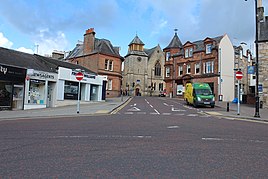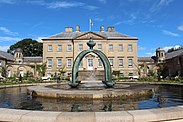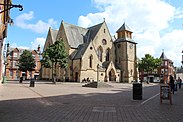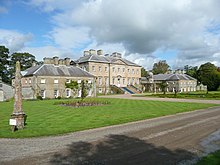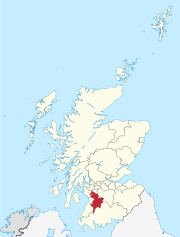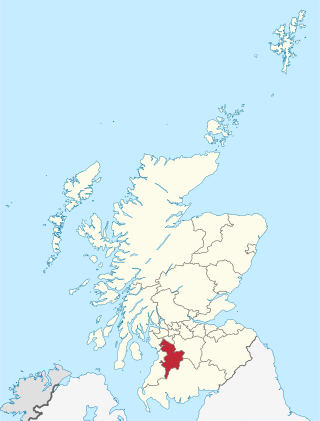
East Ayrshire is one of 32 unitary council areas of Scotland. It shares borders with Dumfries and Galloway, East Renfrewshire, North Ayrshire, South Ayrshire and South Lanarkshire. The headquarters of the council are located on London Road, Kilmarnock. With South Ayrshire and the mainland areas of North Ayrshire, it formed the former county of Ayrshire.

Ayr is a town situated on the southwest coast of Scotland. A former Royal Burgh, today it is the administrative centre of the South Ayrshire Council, and the historic county town of Ayrshire. With a population of 46,982, Ayr is the 15th largest settlement in Scotland and second largest town in Ayrshire by population. The town is contiguous with the smaller town of Prestwick to the north.

Cumnock and Doon Valley was one of nineteen local government districts in the Strathclyde region of Scotland from 1975 to 1996.

Kyle and Carrick was one of nineteen local government districts in the Strathclyde region of Scotland from 1975 to 1996.

Kyle is a former comital district of Scotland which stretched across parts of modern-day East Ayrshire and South Ayrshire. It is supposedly named after Coel Hen, a legendary king of the Britons, who is said to be buried under a mound at Coylton.

Auchinleck is a village 5 miles (8 km) southeast of Mauchline, and 2 miles (3 km) northwest of Cumnock in East Ayrshire, Scotland.
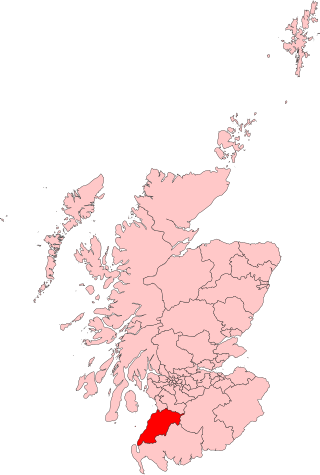
Ayr, Carrick, and Cumnock is a county constituency represented in the House of Commons of the Parliament of the United Kingdom. It was created for the 2005 general election from parts of the old Ayr and Carrick, Cumnock and Doon Valley constituencies. It has been represented since 2019 by Allan Dorans of the Scottish National Party.
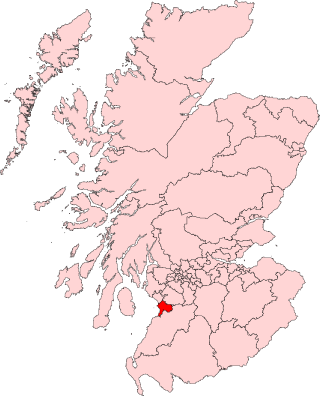
Ayr was a county constituency of the House of Commons of the Parliament of the United Kingdom from 1950 to 2005. It elected one Member of Parliament (MP) by the first-past-the-post system of election.
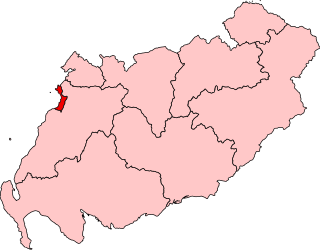
Ayr is a burgh constituency of the Scottish Parliament (Holyrood) covering the town of Ayr in the council area of South Ayrshire. It elects one Member of the Scottish Parliament (MSP) via the plurality electoral system. It is also one of nine constituencies in the South Scotland electoral region which elects seven additional members to the Scottish Parliament via a proportional electoral system known as the Additional Members System which allows for greater accuracy in representation for the region as a whole.

Carrick, Cumnock and Doon Valley is a county constituency of the Scottish Parliament at Holyrood, covering parts of the council areas of South Ayrshire and East Ayrshire. It elects one Member of the Scottish Parliament (MSP) by the plurality method of election. Also, it is one of nine constituencies in the South Scotland electoral region, which elects seven additional members, in addition to the nine constituency MSPs, to produce a form of proportional representation for the region as a whole.

Clydesdale is a constituency of the Scottish Parliament (Holyrood) covering part of the council area of South Lanarkshire. It elects one Member of the Scottish Parliament (MSP) by the plurality method of election. Also, however, it is one of nine constituencies in the South Scotland electoral region, which elects seven additional members, in addition to nine constituency MSPs, to produce a form of proportional representation for the region as a whole.

Carrick, Cumnock and Doon Valley was a county constituency represented in the House of Commons of the Parliament of the United Kingdom from 1983 until 2005. Half of the constituency was incorporated into the new Ayr, Carrick and Cumnock constituency, with the remainder incorporated into the new Central Ayrshire constituency and the expanded Kilmarnock and Loudoun constituency.
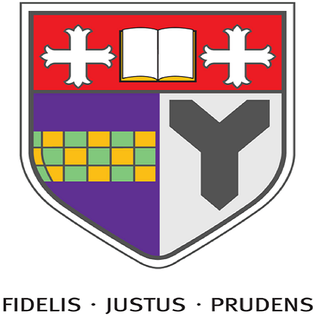
Saint Josephs' Academy is a Roman Catholic secondary school in New Farm Loch, Kilmarnock, East Ayrshire, Scotland. Whilst the school is located in Kilmarnock, it serves the entire Catholic secondary school aged population in East Ayrshire, with the school being the only Roman Catholic secondary school within the local authority area. This means for families in all areas of East Ayrshire, St. Joseph's Academy is a catchment Secondary school. A long-standing inter-authority arrangement sees a small number of primary seven pupils attending St. Xavier’s Primary School in Patna, transition to Queen Margaret Academy located in Ayr, South Ayrshire instead of Saint Josephs' Academy at the start of S1.
Doonfoot is a suburb in the south-west of Ayr, South Ayrshire.

Prior to its uniform adoption of proportional representation in 1999, the United Kingdom used first-past-the-post for the European elections in England, Scotland and Wales. The European Parliament constituencies used under that system were smaller than the later regional constituencies and only had one Member of the European Parliament each.

Kilmarnock and Irvine Valley is a constituency of the Scottish Parliament (Holyrood) covering part of the council area of East Ayrshire. It elects one Member of the Scottish Parliament (MSP) by the plurality method of election. It is also one of nine constituencies in the South Scotland electoral region, which elects seven additional members, in addition to the nine constituency MSPs, to produce a form of proportional representation for the region as a whole.

William Grant is a Scottish Conservative Party politician who was the Member of Parliament (MP) for the Ayr, Carrick and Cumnock UK Parliamentary constituency from June 2017 to November 2019.

The Robert Burns Academy is a secondary school located in Cumnock, East Ayrshire, Scotland, which opened to pupils in October 2020 following the merger of Cumnock Academy and Auchinleck Academy. The current Head Teacher, Peter Gilchrist, also acts as the Head of Barony Campus, meaning he has the responsibility of leading the whole Barony Campus which consists of Robert Burns Academy, Lochnorris Primary School, Cherry Trees Early Childhood Centre and Hillside School.

Carol Mochan is a Scottish Labour politician. She has been a Member of the Scottish Parliament (MSP) for the South Scotland region since the election in May 2021.
